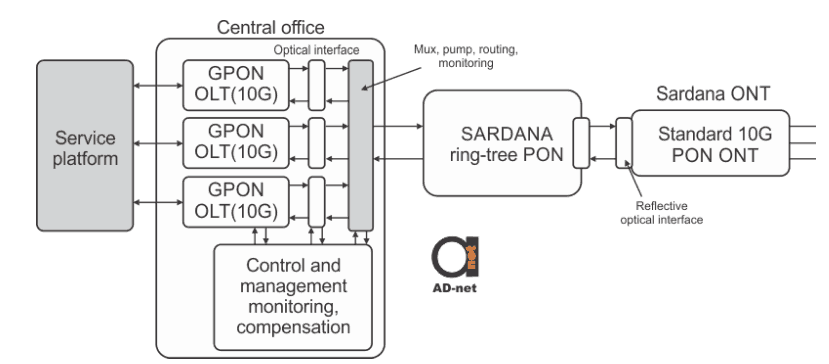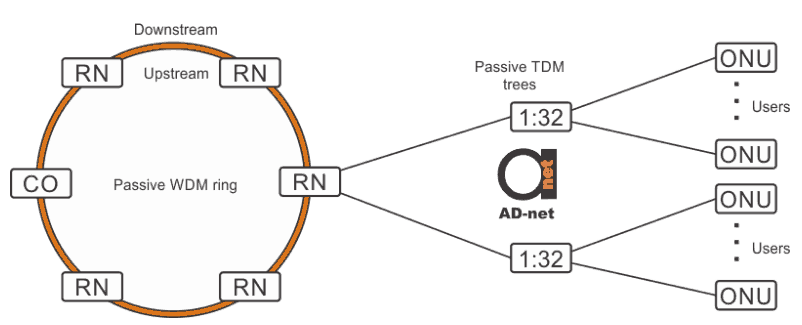Depending on the wavelength assignment, the WDM-PON can be separated into two groups: the CWDM-PON (Coarse Wavelength Division Multiplexing PON) and the DWDM-PON (Dense Wavelength Division Multiplexing PON).
Figure 1 shows eighteen wavelength channels with 20-nm wavelength spacing. This property is common for the CWDM-PON. The 18 wavelengths use spectrum of 1271-1611 nm and do not require strict tuning. Meanwhile thermal regulation is unnecessary with the use of low-cost AWGs (Arrayed Waveguide Gratings). Depending on the wavelength plan or the rate per ONU the choice of the type of laser can change. However, Fabry-Perot lasers are usually used for upstream transmission, while more expensive DFB (Distributed FeedBack) lasers – for downstream.

Figure 1. CWDM wavelength assignments
DWDM-PON is using wavelength spacing of up to 3.2 nm due to a finger granularity. Available DWDM spectrum is between 1528.77 and 1563.86 nm. DWDM-PON exceeds with longer signal distance (70-135 km) than CWDM-PON.
Always growing demand for high-speed bandwidth stimulates research organisations to develop cheaper and more efficient equipment. Development of the FTTH standard motivated Europe to create SARDANA (Scalable Advanced Ring-based passive Dense Access Network Architecture) project. SARDANA is using 32-wavelength WDM/TDM passive fiber ring PON, as shown in Figure 2. It supports multiple OLT communications and multiple user locations. This hybrid Architecture combines WDM ring with TDM access tree. As Figure 3 shows it is achieved with the help of the remote nodes, that can be added at any time, making architecture scalable. SARDANA is using two fibers in the ring, one for each direction of traffic. Tree topology starts from the remote node – each tree gets its own wavelength. This makes remote node use two downstream and two upstream wavelengths at the same time.

Figure 2. High-level SARDANA system architecture
Even if the whole ring is passive, signal still requires amplification at the remote nodes. It is achieved with the help of EDFA (Erbium Doped Fiber Amplifier) located in the central office. EDFA helps to overcome attenuations from transmission, and filter the signal. The maximum number of remote nodes is depending on the amplifier power.
Other end of the network is similarly passive. RSOA (Reflective Semiconductor Optical Amplifier) is used in ONU to generate the upstream carrier by reusing a downstream signal. Upstream signal is having the same wavelength as the downstream one. Interference is avoided with the help of directional couplers.
The general idea behind SARDANA is the ability to realize huge access capacities. In order to popularize the architecture, industry requires inexpensive, mass produced optical equipment.

Figure 3. SARDANA hybrid passive ring-tree architecture


